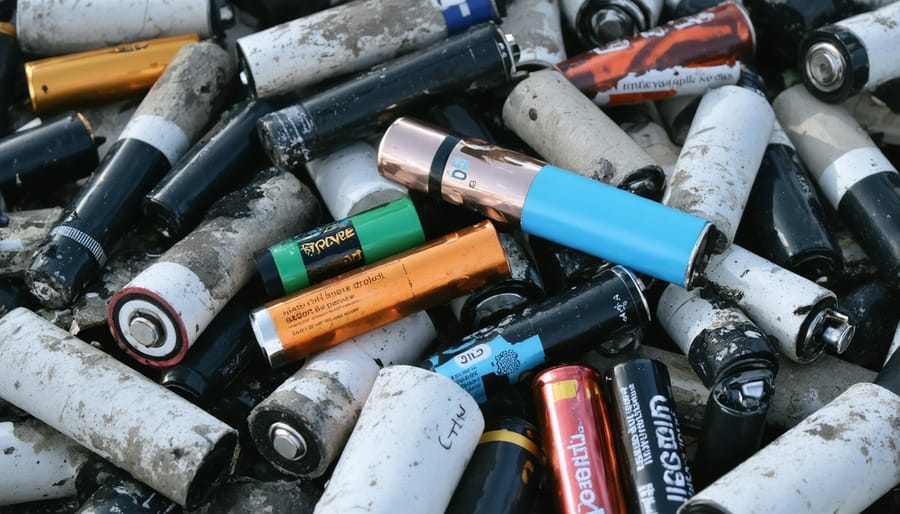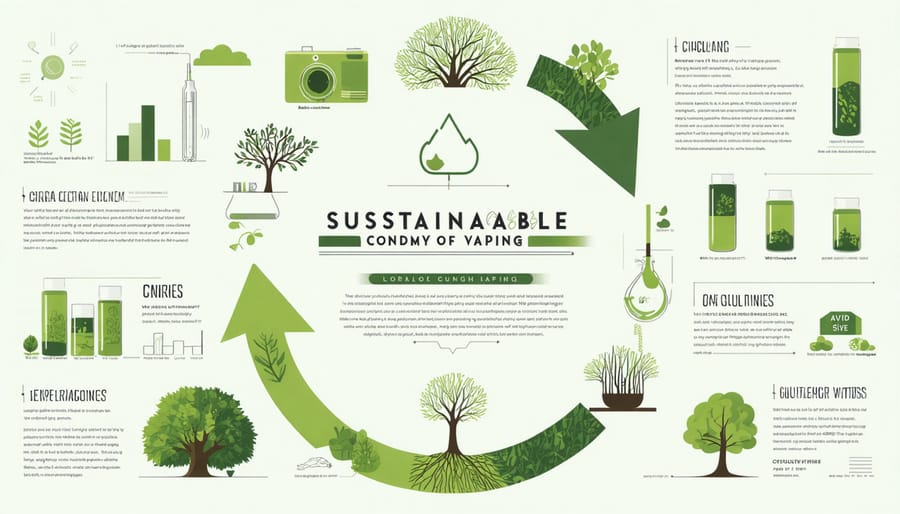Transforming our communities through sustainable vaping practices represents a pivotal shift in environmental stewardship and public health. As Canadian neighborhoods grapple with disposable e-cigarette waste and its environmental impact, innovative solutions are emerging to find out more about responsible vaping practices. The intersection of environmental consciousness and community well-being has sparked a movement towards sustainable vaping alternatives, leading to reduced landfill waste, decreased carbon footprint, and stronger local economies.
Local initiatives across Canada demonstrate how sustainable vaping practices create ripple effects throughout communities – from supporting eco-friendly businesses to fostering environmental education programs. By embracing reusable devices, implementing proper disposal methods, and supporting retailers committed to sustainability, communities are pioneering a more responsible approach to vaping culture. This collective effort not only protects our environment but also builds more resilient, health-conscious neighborhoods for future generations.
The Environmental Challenge of Traditional Vaping
E-Waste Crisis in Local Communities
The surge in disposable vape use has created a mounting e-waste challenge in our communities. Each discarded device contains lithium batteries, electronic components, and plastic materials that often end up in landfills rather than proper recycling streams. Local waste management facilities report a significant increase in vape-related waste, with some communities seeing up to 30% more electronic waste in their collection systems.
Community recycling programs are stepping up to address this issue. Several municipalities have launched specialized collection points for vape devices, ensuring proper disposal and material recovery. Local environmental groups are partnering with vape retailers to create take-back programs, making it easier for users to responsibly dispose of their devices.
The impact extends beyond waste management – these initiatives are creating green jobs and fostering environmental awareness. By choosing sustainable vaping options and supporting local recycling efforts, community members can help reduce the environmental footprint while protecting our shared spaces from harmful waste.

Carbon Footprint Concerns
The manufacturing and distribution of vaping products raise significant environmental safety concerns that our communities must address. Traditional vaping devices often contain single-use plastics, non-recyclable batteries, and electronic components that contribute to electronic waste. The transportation of these products across long distances adds to their carbon footprint through increased emissions.
However, sustainable vaping initiatives are making positive changes. Local manufacturers are implementing eco-friendly production methods, using renewable energy sources, and developing recyclable packaging solutions. Some Canadian companies have established take-back programs, allowing users to return used devices for proper recycling. Community-based distribution networks are reducing transportation distances by working with local suppliers and implementing efficient delivery routes.
By supporting these sustainable practices, we’re not only reducing environmental impact but also creating opportunities for local green businesses to thrive. Many communities are seeing the benefits of shorter supply chains and decreased waste management costs.
Community-Led Sustainable Solutions
Recycling Programs Success Stories
Several Canadian communities have shown remarkable success in implementing vaping product recycling programs. In Vancouver, the “Vape Smart, Recycle Right” initiative collected over 50,000 disposable vaping devices in its first year, preventing harmful materials from entering landfills. The program’s success stems from strategic partnerships between local vape shops, community centers, and waste management facilities.
In Toronto, the “Green Vaping Coalition” established convenient drop-off points at participating retailers, resulting in a 40% increase in proper disposal rates. The program’s educational component helped residents understand the importance of responsible recycling and proper disposal methods.
Halifax’s “Eco-Vape” program demonstrates the power of community collaboration, with local businesses offering incentives for returning used devices. This initiative has diverted approximately 2,000 pounds of electronic waste from landfills and created three new green jobs in the recycling sector.
These success stories highlight how well-organized recycling programs can make a significant environmental impact while fostering community engagement and creating economic opportunities. The key to their success lies in making recycling accessible, educating the public, and maintaining strong partnerships between stakeholders.

Educational Outreach Impact
Educational outreach programs across Canadian communities are making significant strides in promoting sustainable vaping practices. Local organizations have successfully implemented awareness campaigns that reach diverse demographics, from youth groups to senior citizens. These initiatives typically combine workshops, interactive demonstrations, and community events to educate residents about proper disposal methods and environmental responsibility.
Community centers and libraries have become vital hubs for these educational efforts, hosting monthly information sessions that bring together environmental experts and community members. The impact is measurable, with participating communities reporting up to 40% increase in proper vaping waste disposal and a growing interest in sustainable alternatives.
Several municipalities have launched innovative school-based programs, engaging students in environmental stewardship while fostering open discussions about responsible choices. These programs often feature peer-led education components, which have proven particularly effective in reaching younger audiences.
The success of these outreach efforts relies heavily on collaboration between local businesses, environmental groups, and health organizations. Together, they create comprehensive educational materials that address both environmental concerns and community well-being, ensuring a more sustainable future for all residents.

Economic Benefits of Sustainable Vaping
Job Creation Through Green Initiatives
The shift towards sustainable vaping practices is creating exciting new job opportunities across Canadian communities. Local recycling initiatives are employing technicians and program coordinators to manage vape device collection and processing. Small businesses focusing on eco-friendly vaping alternatives are emerging, offering positions in retail, customer education, and sustainable product development.
Through community investment opportunities, green vaping enterprises are partnering with environmental organizations to create roles in waste management and environmental consultation. Manufacturing facilities retooling for sustainable production are hiring workers skilled in green technologies and sustainable materials handling.
These initiatives also support indirect employment growth in sectors like eco-friendly packaging, transportation logistics, and community outreach. Training programs are developing to prepare workers for these emerging roles, while local environmental education centers are expanding their staff to include sustainable vaping practices in their curriculum.
Cost Savings for Municipalities
When communities embrace sustainable vaping practices, they often discover significant cost savings in waste management operations. Traditional disposable vapes contribute substantially to municipal waste handling expenses, but with the shift toward eco-friendly alternatives, cities are reporting notable reductions in collection and processing costs.
For instance, several Canadian municipalities have documented up to 15% decreases in specialized waste handling expenses after implementing sustainable vaping initiatives. These savings come from reduced need for special handling of electronic waste and fewer resources dedicated to cleaning up improperly discarded vaping products from public spaces.
The money saved through these initiatives is being redirected to other community programs, creating a positive cycle of environmental and social benefits. Some cities are using these funds to expand their recycling programs or invest in public education about sustainable practices. By encouraging the use of recyclable and reusable vaping products, communities are not just reducing their environmental footprint – they’re making smart financial decisions that benefit everyone.
Partnership Success Models
Across Canada, innovative partnerships are proving that collaboration is key to addressing sustainable vaping challenges. The city of Vancouver stands out with its groundbreaking “Green Vape Initiative,” where local vape shops have partnered with environmental organizations to create a comprehensive recycling program. This partnership has successfully collected and properly disposed of over 50,000 vaping devices in its first year alone.
In Toronto, the “Community Clean Coalition” brings together manufacturers, retailers, and neighborhood groups in a unified effort. Their deposit-return system for vaping products has achieved an impressive 75% return rate while funding community green spaces through the collected deposits.
The success of these partnerships often relies on three key elements: clear communication channels, shared responsibilities, and measurable goals. For instance, Halifax’s “Sustainable Vaping Alliance” demonstrates this perfectly through their monthly stakeholder meetings, divided cleanup responsibilities, and transparent impact reporting.
Small communities are also making big waves. In Guelph, local businesses have joined forces with environmental educators to create awareness programs in schools and community centers. Their collaborative approach has reduced vaping-related litter by 40% in public spaces.
These partnerships extend beyond immediate stakeholders. Indigenous communities in British Columbia have developed innovative programs combining traditional environmental stewardship with modern recycling practices. Their model of inclusive decision-making and community-led initiatives has become a blueprint for other regions.
The key takeaway from these success stories is that sustainable solutions emerge when businesses take responsibility, communities stay engaged, and environmental experts provide guidance. These partnerships not only address immediate environmental concerns but also build stronger, more connected communities.
Future Directions and Recommendations
As we look toward the future of urban communities, several promising initiatives are emerging to address sustainable vaping practices. Community-led recycling programs for vaping devices and components are gaining traction, with several municipalities planning to launch dedicated collection points by 2024.
We recommend establishing neighborhood-based education programs that focus on proper disposal methods and environmental awareness. Local organizations can partner with retailers to create incentive programs, encouraging users to return used devices and components for proper recycling.
Another crucial step is developing comprehensive waste management guidelines specifically for vaping products. Communities should consider implementing deposit-return systems, similar to those used for bottles and cans, to motivate responsible disposal practices.
Digital tracking systems for vaping waste collection could help measure community impact and adjust strategies accordingly. We encourage communities to form sustainability committees that include diverse stakeholders – from healthcare professionals to environmental experts – to guide these initiatives effectively.
Looking ahead, communities should focus on:
– Supporting local recycling innovations
– Creating youth environmental education programs
– Developing partnerships with manufacturers for sustainable product design
– Establishing clear metrics for measuring progress
– Building cross-community networks to share successful strategies
Together, these approaches can help create more sustainable and environmentally conscious communities while addressing the challenges of vaping waste management.
Together, we can create a more sustainable future for our communities through mindful vaping practices. By embracing eco-friendly alternatives, supporting local recycling initiatives, and encouraging responsible disposal methods, we’re already making significant strides. The positive impact extends beyond environmental benefits, creating economic opportunities and fostering stronger community bonds. Now is the time to get involved – whether by joining local sustainability groups, organizing community cleanup events, or simply spreading awareness about sustainable vaping practices. Every small action counts. Reach out to your local environmental organizations, participate in community discussions, and share your sustainable vaping journey with others. By working together, we can build cleaner, healthier, and more resilient communities for generations to come.
